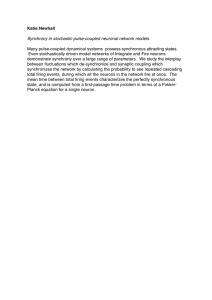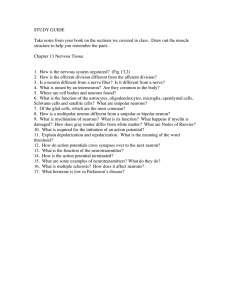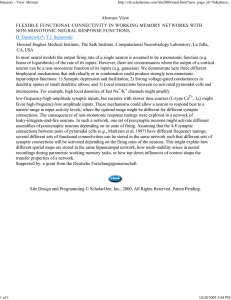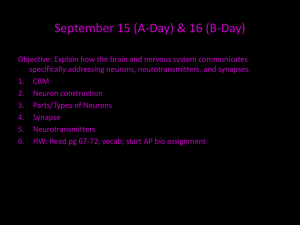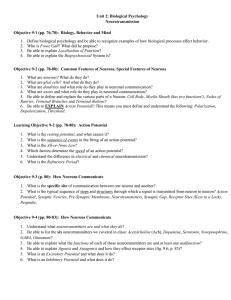Defining Time in a Minimal Hippocampal CA3 Model by Matching... Associative Synaptic Modification and Input Pattern Duration
advertisement
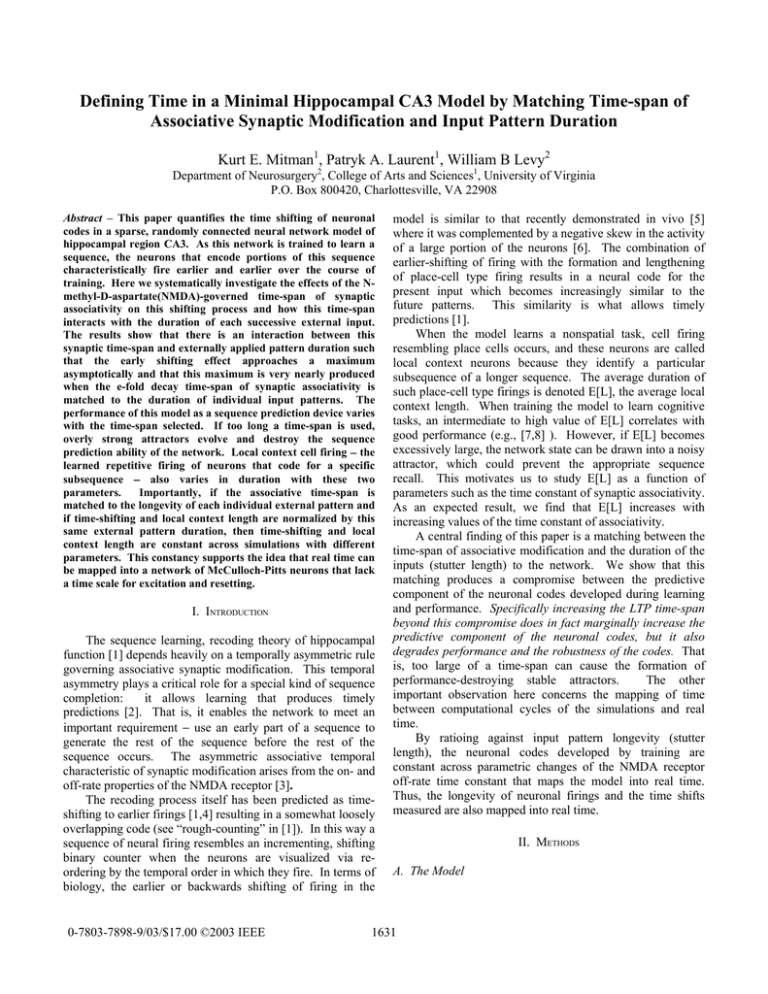
Defining Time in a Minimal Hippocampal CA3 Model by Matching Time-span of
Associative Synaptic Modification and Input Pattern Duration
Kurt E. Mitman1, Patryk A. Laurent1, William B Levy2
Department of Neurosurgery2, College of Arts and Sciences1, University of Virginia
P.O. Box 800420, Charlottesville, VA 22908
Abstract – This paper quantifies the time shifting of neuronal
codes in a sparse, randomly connected neural network model of
hippocampal region CA3. As this network is trained to learn a
sequence, the neurons that encode portions of this sequence
characteristically fire earlier and earlier over the course of
training. Here we systematically investigate the effects of the Nmethyl-D-aspartate(NMDA)-governed time-span of synaptic
associativity on this shifting process and how this time-span
interacts with the duration of each successive external input.
The results show that there is an interaction between this
synaptic time-span and externally applied pattern duration such
that the early shifting effect approaches a maximum
asymptotically and that this maximum is very nearly produced
when the e-fold decay time-span of synaptic associativity is
matched to the duration of individual input patterns. The
performance of this model as a sequence prediction device varies
with the time-span selected. If too long a time-span is used,
overly strong attractors evolve and destroy the sequence
prediction ability of the network. Local context cell firing − the
learned repetitive firing of neurons that code for a specific
subsequence − also varies in duration with these two
parameters.
Importantly, if the associative time-span is
matched to the longevity of each individual external pattern and
if time-shifting and local context length are normalized by this
same external pattern duration, then time-shifting and local
context length are constant across simulations with different
parameters. This constancy supports the idea that real time can
be mapped into a network of McCulloch-Pitts neurons that lack
a time scale for excitation and resetting.
I. INTRODUCTION
The sequence learning, recoding theory of hippocampal
function [1] depends heavily on a temporally asymmetric rule
governing associative synaptic modification. This temporal
asymmetry plays a critical role for a special kind of sequence
completion:
it allows learning that produces timely
predictions [2]. That is, it enables the network to meet an
important requirement − use an early part of a sequence to
generate the rest of the sequence before the rest of the
sequence occurs. The asymmetric associative temporal
characteristic of synaptic modification arises from the on- and
off-rate properties of the NMDA receptor [3].
The recoding process itself has been predicted as timeshifting to earlier firings [1,4] resulting in a somewhat loosely
overlapping code (see “rough-counting” in [1]). In this way a
sequence of neural firing resembles an incrementing, shifting
binary counter when the neurons are visualized via reordering by the temporal order in which they fire. In terms of
biology, the earlier or backwards shifting of firing in the
0-7803-7898-9/03/$17.00 ©2003 IEEE
model is similar to that recently demonstrated in vivo [5]
where it was complemented by a negative skew in the activity
of a large portion of the neurons [6]. The combination of
earlier-shifting of firing with the formation and lengthening
of place-cell type firing results in a neural code for the
present input which becomes increasingly similar to the
future patterns. This similarity is what allows timely
predictions [1].
When the model learns a nonspatial task, cell firing
resembling place cells occurs, and these neurons are called
local context neurons because they identify a particular
subsequence of a longer sequence. The average duration of
such place-cell type firings is denoted E[L], the average local
context length. When training the model to learn cognitive
tasks, an intermediate to high value of E[L] correlates with
good performance (e.g., [7,8] ). However, if E[L] becomes
excessively large, the network state can be drawn into a noisy
attractor, which could prevent the appropriate sequence
recall. This motivates us to study E[L] as a function of
parameters such as the time constant of synaptic associativity.
As an expected result, we find that E[L] increases with
increasing values of the time constant of associativity.
A central finding of this paper is a matching between the
time-span of associative modification and the duration of the
inputs (stutter length) to the network. We show that this
matching produces a compromise between the predictive
component of the neuronal codes developed during learning
and performance. Specifically increasing the LTP time-span
beyond this compromise does in fact marginally increase the
predictive component of the neuronal codes, but it also
degrades performance and the robustness of the codes. That
is, too large of a time-span can cause the formation of
performance-destroying stable attractors.
The other
important observation here concerns the mapping of time
between computational cycles of the simulations and real
time.
By ratioing against input pattern longevity (stutter
length), the neuronal codes developed by training are
constant across parametric changes of the NMDA receptor
off-rate time constant that maps the model into real time.
Thus, the longevity of neuronal firings and the time shifts
measured are also mapped into real time.
II. METHODS
A. The Model
1631
The model simulates the CA3 region of the
hippocampus, an area sometimes thought to be the center of
associative memory due to the presence of recurrent
connectivity [9,10]. Because we implement an asymmetric
synaptic modification rule [11], the CA3 region is also able to
make associations across time. Therefore, context-dependent
sequence learning takes place in this model (see [12], for a
review).
The model reflects the biology of the hippocampus, yet
at the same time aiming for easy interpretation via
minimality. The network is comprised of McCulloch-Pitts
binary neurons. The recurrent connectivity between neurons
is random and sparse. The connections to the CA3 region
from the entorhinal cortex and dentate gyrus are combined
and represented as a single input vector. In contrast to the
visual model, here inhibition is implemented using a kwinners-take-all competitive rule. The following equations
illustrate the dynamics of the model:
For neuronal excitation,
The term µ in the weight modification equation is the
learning rate constant for weight changes and depends on
stutter length, µ = [(1.05)1/stutter – 1]. The term α in the
presynaptic updating of Z i (t ) is the decay time constant of
the NMDA receptor. We assume e-fold decay in the NMDA
receptor after 100 ms. We can represent this decay in
discrete time as the number of time steps it takes for Z i to
reach 1/e if no further excitation arrives on input line i. Thus,
the length of real time represented by each time step (in ms) =
–100 / [ log(α) × e].
All simulations used 8% connectivity (e.g. P(cij = 1) =
.08), where self connections are not allowed and n=4096.
This value of connectivity is inferred from the projections of
the roughly 83,000 neurons in the septal one-third of CA3 of
the rat hippocampus. Random synaptic transmission failures
occur at each synapse at a rate of 20%. The results presented,
however, are not significantly different from those where
synaptic transmission failures were absent from the network
model.
y j (t ) = ∑ i =1 cij × Wij × Z i (t − 1) ;
B. Inputs
for output,
The network was trained on sequences of ten orthogonal
(non-overlapping) patterns. Each pattern was presented for
multiple time steps. The number of time steps each pattern is
activated is called “stutter length.” An input pattern on one
time step activated 64 neurons randomly chosen from sets of
96 neurons. That is, on each time step, a random 67% of the
neurons of the appropriate external input pattern fire (see Fig.
1, top graph).
There are two types of sequences which are simulated:
training trials, in which the entire externally driven sequence
is presented and synaptic modification is allowed to occur
and testing trials, in which part or all of the sequence is
presented and no synaptic modification is allowed to occur.
n
1
Z j (t ) =
0
if y j (t ) ≥ θ
otherwise,
x j (t ) = 1
where yj(t) is the net excitation for the jth neuron at time t, for
j ∈ {1,…,n} neurons, Zj(t) is the output, Wij(t) is the weight
of the connection from neuron i to j; cij ∈ {0, 1} is the
connection indicator, xi ∈ {0, 1} indicates which neuron are
activated by the entorhinal cortex/dentate gyrus (externals),
and θ is the threshold, determined each time step such that
only the 7.5% of neurons with the highest activity have an
output of 1.
Synaptic weights are modified in accordance with a
temporally asymmetric Hebbian rule [11,13,14] and have a
time-spanning associative capability that models a saturationdecay model of the NMDA receptor. The equations are as
follows:
For time-span associativity a saturate and decay variable
Z i (t ) is used,
1
Z i (t ) =
α × Z i (t − 1)
if Zi (t ) = 1, and
otherwise
for synaptic modification,
Wij (t + 1) = Wij (t ) + µ Z j (t ) ( Z i (t − 1) − Wij (t ) ) .
C. Determining Shift
Shift is a measure of the change in temporal position of
neural firing as a function of training. The metric used here
compares neuronal firing after an “early” training trial to the
final training trial. The “early” training trial is determined to
be that when the network has achieved a stable initial firing
distribution across time-steps even though firing is still
mostly random at the beginning of training due to the random
connectivity (See Fig. 1). We find that after 5 training trials
most neuronal initial firing times can be reliably predicted
across the sequence. We ignore, however, neurons from the
final two patterns of the sequence because of a
nonrepresentative end of sequence effect.
When α is non-zero, shift always tends to be in the
earlier direction for the neurons in a network. We do find
that some neurons which originally fired at the beginning of
sequences appear to shift later (towards the end of the
1632
sequence) by large numbers of time steps. This “later
shifting”, however, is unrelated to the earlier-shifting
phenomenon being studied. We hypothesized these neurons,
which can later-shift by as much as 75% of the sequence, are
inefficient coding neurons from the early patterns which
through the process of synaptic modification are
depotentiated, cease firing, and then are recruited later to
code for patterns in the middle or at the end of the sequence.
Also, in the case of neurons which have inputs from externals
as well as recurrents driven by those same externals marginal
forward shifting is possible, representing a different
mechanism. A more detailed analysis of these other
mechanisms is still necessary.
For the first two or three training trials neural firing is
almost entirely random. However, by trial five it is possible
to reliably identify a particular time step with the firing of a
particular neuron. With additional training trials the firing of
the neurons begins to shift earlier in the sequence. Earlier
shifting is clearly demonstrated by the externally activated
neurons (see Fig. 1). The average shift of the externally
activated neurons at the end of training is around fourteen
time steps or 154 ms or just over one and a half patterns.
D. Measuring Performance
Successful learning is defined as a simulation being able
to complete 80% of the training sequence during recall
testing (only the first input pattern is externally activated) and
doing so without skipping more than two patterns and
without reaching an inappropriate stable state before the end
of the sequence (see Fig. 2).
To determine which external pattern is being represented
at each time step of recall, the neuronal firing is compared to
the previously recorded neuronal firing on every time step of
training (where all patterns were externally activated). The
time step of training which is most similar to that of the
network state at time t of recall (as determined by an inner
product of the firing) is the input represented by the network
during recall at time t.
E. Measuring E(L)
Local context firing length measures the contiguous
period of time over which neurons fire. Published findings
from our laboratory show that an intermediate to high
average value of local context length, E(L), is a good
predictor of learning (e.g., [7,8] ). We measure local context
length using externally driven sequences and then count the
period of time from a neuron’s first time-step of firing to its
last time-step of contiguous firing. Temporally contiguous
firing is defined as two firings with less than three non-firing
time-steps between the firings (e.g. on-off-off-on are
temporally contiguous, on-off-off-off-on are not).
Because failure prone synaptic transmission and noisy
inputs are being used here, some neurons flicker on-off-on
while still being a local context neuron. The entire length
was used to value such a neuron (e.g., on-off-on implies a
length of 3). Some other neurons are randomly activated by
the random processes just mentioned and are not strongly
associated with any particular subsequence, or time-step, of
the training sequence. These neurons were characterized by
wide gaps between firing times and lack of temporally
adjacent firings. Such neurons are categorized as unused.
Fig. 1. Training produces time shifting to earlier positions of externally
activated neurons by extending context length. Firing of the first 1000
neurons of the 4096 total neurons in a network during the fifth (upper figure)
and 250th (lower figure) training trials. The external inputs to the network
include neurons 1 through 960. Neurons 961 through 1000 are recurrently
activated if they fire. The inputs are a sequence of orthogonal patterns, each
on for nine time-steps (stutter=9). The rectangular blocks along the diagonal
in the upper figure are the externally activated neurons. These rectangles are
not solid because of input noise that randomly deselects external activation.
Typically, however, the time-shifting of the externally
activated neurons tends to be less pronounced than that of
purely, recurrently-activated neurons. Because an externally
activated neuron is turned regardless of other activity, there is
strong depotentiation of the recurrent inputs to these neurons,
synaptic weakening beyond a reclaimable weight value.
Thus, such a neuron tends toward a functional disconnection
from most other neurons, thereby decreasing the likelihood
that it can be activated earlier.
III. RESULTS
1633
The earlier shifting seems to exhibit asymptotic
behavior, that is by trial 150 neurons are reliably firing to a
particular subsequence of the training sequence and shift only
slightly as training proceeds. The average number of time
steps shifted at the end of training is quite sensitive to the
value of α, particularly when –log(α) > 1/stutter (See Fig. 3).
While there is no local minimum at e-fold decay (αstutter = e –1
≈ 0.3679), beyond e-fold decay rates, earlier-shifting
approaches an asymptotic value (See Fig. 4). The mean
amount of earlier-shifting appropriately reaches the
maximum backward shift by setting the time-span of
associativity to the e-fold decay value suggested by biology.
The results show that the e-fold decay rate yields the
maximum earlier-shifting with the minimal amount of code
and learning degradation (only 15% of networks fail to
complete the sequence on recall). Increasing α even slightly
beyond the e-fold decay rate results in network failure in
more than 50% of networks (See Fig. 4). Therefore,
matching the time-span of associativity to the input pattern
duration (in the model, matching the parameter alpha to the
parameter stutter) is arguably a useful compromise for the
model and, as a hypothesis, explains the similarity between
the time of a theta cycle and the NMDA-R off-rate time
constant in rats.
Fig. 2. Example of a simulation that satisfies (top) and fails (bottom) to
meet the 80% learning criterion on recall. Both graphs are testing trials
after 250 training trials. During the testing trial the first pattern is presented
(dark rectangle) and then the network is allowed the free run. The top graph
has a matched value of α to the stutter (note, on recall the sequence is
compressed by a factor ~ 2). The bottom graph has a value of α above the
matching value and falls into a steady state attractor.
Fig. 3. Time shift histogram of the recurrent neurons in 10 networks with
externally activated neurons excluded. Shift for each neuron is defined as
the change in onset time of its initial firing after trial 5 vs. trial 250 (see
Methods). Temporal shifting in the network during learning is
predominantly in the earlier direction. The median total shift is
approximately -34 time steps. However, this figure does not take context
length, E(L), into account, and so does not fully reflect the skewing of place
fields. The stutter was 9 and α was matched to this stutter length.
1634
Fig. 4. The effects of α on performance and shift at stutter-length five.
When α is matched to stutter-length ( = 0.82), the time shift (upper figure)
has essentially achieved its maximum backward value. However, at this
value an overly strong attractor is beginning to develop to the detriment of
performance (lower figure), at least for the competitive networks used here.
Each point represents the average of 20 randomly connected networks.
-1
Context Length
Shift
3
-2
2
-3
1
-4
Context Length / Stutter
Time Steps Shifted / Stutter
At the beginning of training, the randomness in
connectivity and random neural firing imply that, besides the
externally activated neurons, almost no place-cell type firing
(local context firing) is present in the network. However,
after five training trials, such local context firing begins to
emerge. These regular firings are typically on the order of
one or two time steps in duration. With repeated training
trials the firing length for context neurons increases, and noncontext neurons begin to stop firing altogether. We find that
E(L) at the end of training is sensitive to α, increasing almost
linearly with increasing α. This result is closely related to the
earlier-shifting of neurons. That is, neurons not only begin
their context firing earlier in each trial as training progresses,
but they maintain part of their previous firing times. As a
result, overall local context firing times lengthen for such
neurons. At the matching e-fold decay rates, E(L) is
typically 1.9 times the input pattern duration (see Fig. 5).
0
3
5
7
9
Stutter Length
Fig. 5. Normalized time shifting and normalized context length are
constants. Mean time shifting divided by stutter length and median context
length divided by stutter length are plotted for four different values of stutter
with each stutter length matched by the e-fold, decay constant α. Because a
constant value is produced, time may be physically and consistently
represented in the model by the ratioing and matching α to stutter. Each
point is the average of ten random networks. The slopes of the two
regression lines is approximately 0.01 and do not represent a significant
deviation from zero in the slope.
The meaningfulness of matching stutter length to the
associative time span is emphasized by normalized
measurements of average time shifting and of average context
length and is illustrated by the mean zero slope lines of Fig.
5. That is, if we divide training-induced average context
length by stutter length when training at the matched time
span, the model becomes parameter independent. Thus the
matching of stutter length and time span becomes an explicit
definition of time in the model because the associative time
span is measurable and available from experimental work.
Moreover, the normalized shift value and the normalized
context length, E(L), are a physiological prediction if we
assume one complete pattern cycle is one complete theta
cycle. And there is another prediction: slow animals − like
humans − have a slower NMDA-R off-rate time constant in
CA3 than fast, small animals like rats and mice.
IV. DISCUSSION
Most of these paragraphs address the origin of the
earlier-shifting phenomenon across training.
The last
paragraph points out a general hypothesis about the evolved
function and parameterization of the hippocampus.
Because of the direct externally activated excitation and
because of indirect external excitation through recurrent
neurons, any one recurrent neuron will be variously biased to
fire as a function of time within a training trial (at the outset
of training). Because the external activation is stuttered, the
bias of any one, particular recurrent neuron is also stuttered.
That is, an approximately constant bias covers a more-or-less
contiguous time interval equal to the stutter-length for such a
neuron. Now hypothesize random firing of recurrent neurons
reflecting such biases, then we claim that the temporally
asymmetric synaptic modification rule produces a tendency
for such neurons to fire earlier over the course of training for
two reasons:
First, because of the temporal asymmetry of the synaptic
modification rule, only those inputs turning on somewhat
before a postsynaptic neuron fires, or would tend to fire due
to a strong bias, will on average potentiate. Contrariwise,
those inputs tending to turn on afterward or not turn on at all
will, on average, have their synapses weakened. Thus, the
inputs that get strengthened are the ones that turn on earlier.
But again recall, these inputs too are biased to turn on for
several steps just as the relevant postsynaptic neuron is biased
toward firing for several time-steps. So as these inputs
strengthen, the postsynaptic neuron will begin to fire earlier.
These ideas, however, need to be generalized.
Consider now two sets of equal biases that excite the
same postsynaptic neuron but are at different noncontiguous
places in the sequence. Just by chance one bias will grow
stronger than the other because of synaptic modification and
the random aspects of the inputs. Then this stronger bias will
tend to wipe out the weaker bias by virtue of the synaptic
modification rule weakening the synaptic inputs through
which the weaker bias is expressed.
Second, if any one particular neuron is biased strongly
enough so it begins to fire with regularity in response to a
particular subsequence, this neuron will contribute to the bias
of other neurons just as if it were an externally activated
neuron. The fact that this particular neuron is shifting earlier,
in accordance with the reasons just above, results in a
cascade of earlier shifting. That is, as a set of temporally
associated neurons shift earlier so will the neurons they
activate. Thus, it makes sense to refer to an earlier-shift or
backward cascade that can propagate through assemblies of
coding neurons over successive trials.
The earlier shifting of neurons can be controlled by the
value of α. We take α to be the rate constant for the
unbinding of glutamate from the NMDA receptor. We
1635
propose that the role of hippocampal recoding is a
compromise between maximizing the predictive value of the
codes developed while preserving the ability of the CA3 to
sequence. However, as we increase α we find that there is a
point at which overly strong associations create noisy stable
attractors, destroying the sequencing capabilities of the
sparsely connected recurrent network.
Neurophysiological findings are consistent with an e-fold
decay rate in which the presynaptic neuron's contribution to
LTP decreases. Presumably the e-fold decay rate arises from
the unbinding of a glutamate saturated NMDA-R system. As
such, we can write the unbinding as proportional to e-t⋅constant,
for some constant that we set to one. Suppose at t = 0, the
saturated system has a value of one. Then on the next
timestep, ∆t, its value is α; that is, α = e-∆t. But ∆t is
1/(stutter length) because stimulus longevity is constant no
matter how temporally refined it is represented. The central
result is that simulations of our model imply this theoretical
relationship to be optimal for sequence learning, a result
foreshadowed by the compression result in [15].
[11]
ACKNOWLEDGMENT
[12]
This work was supported by David A. Harrison III
research grants to K.E.M and P.L., by NIH MH48161,
MH63855 and RR15205 to WBL; and NSF NGSEIA9974968, NPACI ASC-96-10920, and NGS ACI-0203960 to
Marty Humphrey. We also thank Aaron Shon, Sean Polyn,
David Sullivan, and Xiangbao Wu for their comments on
early versions of the text.
REFERENCES
[1]
[2]
W.B Levy, “A computational approach to hippocampal function,” in
Computational modeling of learning in simple neural systems, R. D.
Hawkins and G. H. Bower, Eds. Orlando, FL: Academic Press, 1989,
pp. 243 - 305.
W.B Levy, X.B. Wu, and R.A. Baxter, “Unification of hippocampal
function via computational/encoding considerations.” in Proc. Third
Workshop on Neural Networks: from Biology to High Energy
Physics. Intl. J. Neural Sys., vol. 6, (Supp.), (D. J. Amit, P. del
1636
[3]
[4]
[5]
[6]
[7]
[8]
[9]
[10]
[13]
[14]
[15]
Guidice, B. Denby, E. T. Rolls and A. Treves, Eds.),
Singapore:World Scientific Publishing, 1995, pp. 71-80.
W.R. Holmes and W.B Levy, “Insights into associative long-term
potentiation from computational models of NMDA receptormediated calcium influx and intracellular calcium concentration
changes,” J. Neurophysiol., vol. 63(5), pp.1148-68, 1990.
K.I. Blum and L.F. Abbott, “A model of spatial map formation in the
hippocampus of the rat,” Neural Comput., 8, pp. 85-93. 1996.
M.R. Mehta, C.A. Barnes, and B.L. McNaughton, “Experiencedependent, asymmetric expansion of hippocampal place fields,”
Proc. National Acad. Sci., USA, 94, pp.8918-8921. 1997.
M.R. Mehta, M.C. Quirk, and M.A. Wilson, “Experience-dependent,
asymmetric shape of hippocampal receptive fields,” Neuron, 25,
pp.707 -715. 2000.
A.P. Shon, X.B. Wu, D.W. Sullivan and W.B Levy, “Initial state
randomness improves sequence learning in a model hippocampal
network,” Phys. Rev. E, vol 65, 031914. 2002.
X.B. Wu, J. Tyrcha, and W.B Levy, “A neural network solution to
the transverse-patterning problem depends on repetition of the input
code,” Biol. Cybern., 79, 1998, 203-213.
D. Marr, “Simple memory, a theory for archicortex,” Phil. Trans.
Roy. Soc. London, 262, 23-81, 1971
E.T. Rolls, “A theory of hippocampal function in memory,”
Hippocampus, 6, pp. 601-620. 1996.
W.B Levy, and O. Steward, “Temporal contiguity requirements for
long-term associative potentiation/depression in the hippocampus,”
Neuroscience, 8, pp.791-797. 1983.
W.B Levy, “A sequence predicting CA3 is a flexible associator that
learns and uses context to solve hippocampal-like tasks,”
Hippocampus, 6(6), pp. 579 - 591. 1996.
W.B Levy, and P. Sederberg, “A neural network model of
hippocampally mediated trace conditioning,” in IEEE International
Conference on Neural Networks, vol. 1, pp. 372-376. Piscataway,
NJ: Institute of Electrical and Electronics Engineers. 1997.
P. Rodriguez, and W.B Levy, “A model of hippocampal activity in
trace conditioning: Where's the trace?” Behav. Neurosci. 115, 2001,
1224-1238.
D.A. August, and W. B Levy, “Temporal sequence compression by
an integrate-and-fire model of hippocampal area CA3.”
J.
Computational Neurosci., 6, 1999, 71-90.

